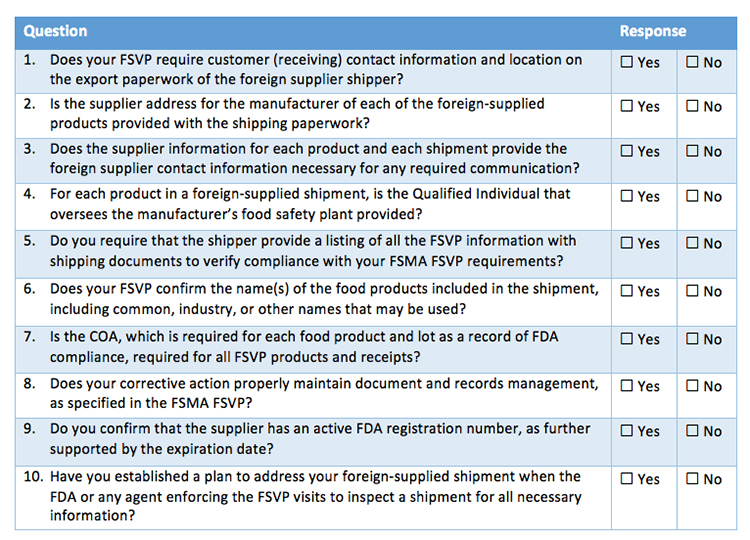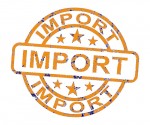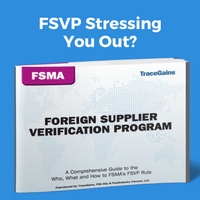From farm to fork, food produced today goes through more hands than ever before. A greater number of players in the production of even a single product could increase that the risk for foodborne illness. Not only do companies need to check incoming and outgoing products from their own facilities, but they also need to consider whether products that they are importing from other countries are compliant with local regulations, and whether the products that they are exporting are compliant with the regulations of the destination country.
The current traceability standard of “one step forward, one step back’”is less and less suited for the current global marketplace, and governments are demanding more. Handling all this information is a challenge for food producers of all sizes, around the world.
Taking Traceability Global with FSVP
Needless to say, with 600 million people contracting foodborne illnesses every year, there is a dire need for food traceability and transparency in the food supply chain. If and when something goes wrong, traceability gives oversight agencies greater visibility investigating the root causes of an outbreak to prevent further risk to the public. It also allows companies to minimize the financial impact of a recall if they are able to pinpoint exactly which lot numbers of their products are affected.
In response to the changes in the food industry, in 2011 the USFDA introduced FSMA to implement a more proactive food safety regulatory system. With FSMA came the Foreign Supplier Verification Program (FSVP), which basically extends FSMA regulations to companies supplying food to the United States. All U.S. importers are now required to monitor and manage their foreign suppliers through six steps of hazard analysis, record keeping and more. Given the complexity of the global food supply chain, this is by no means an easy undertaking and it is clear that technology is crucial to achieving this granular level of data management alone. Blockchain technology, however, might be the answer to this problem—and many other related ones.
What is Blockchain Technology?
Evolving from the digital financial world, blockchains are distributed databases that build a growing chain of ordered records, called blocks. This means that any type of information can be stored in a chronological, consistent and secure way; even if multiple users are involved, it is extremely difficult to alter a blockchain.
Since any information on the blockchain is shared with all of its users, they can view any transactions made historically and in real-time. Theoretically, this could allow authorities to pinpoint food problems within minutes, when previously it would take days, potentially saving many lives in the process.
Blockchain in Action in the Food Industry
In 2016, retail giant Walmart started using a pilot version of the technology in its stores, tracking two products using blockchain: A packaged produce item in the United States and pork in China. Walmart announced that the results were “very encouraging,” noting that using blockchain technology could dramatically increase the speed of traceability from days to minutes. In fact, Walmart is now taking it to the next level with a collaboration with one of China’s largest retailers, JD.com, and their suppliers, to bring a higher level of food safety to China.
Other major food suppliers and retailers—Dole, Driscoll’s, Golden State Foods, Kroger, McCormick and Company, McLane Company, Nestlé, Tyson Foods and Unilever—have also signalled their intention to work with IBM to create blockchain-based solutions. Blockchain technology is even being used to track the movement of tuna through the ocean and all the way to the consumer.
At the same time, implementing blockchain technology throughout the industry is a mammoth task. As of now, blockchain technology has a problem with scaling up and can only process a limited number of transactions per second, which would not be sufficient given the needs of the global supply chain. According to Coindesk, each transaction costs about $0.20, and can only store 80 bytes of data, so the bill might become quite hefty as well.
There’s also the fact that the food industry is traditionally slow to adopt new technologies. It’s not just about big players like Walmart—small, medium, and large businesses alike need to come onboard in order for this to become an industry-wide standard.
Can FSVP Unlock the Potential for Blockchain Technology?
There are several reasons why blockchain technology could be the key to tackling the complex challenge that is tracking and verifying foreign suppliers. Blockchains can help increase transparency and communication across the food supply chain, ensuring that there are no gaps and that records are widely available and up to date. When all the information about suppliers and products is easily accessible, the potential to increase the speed of recall response is very high.
Blockchain technology is also suited to FSVP’s goals, specifically. One of the main goals of FSVP and FSMA generally is to tackle the issues of food fraud, intentional adulteration and bioterrorism that are unique problems of our time, in terms of scale if nothing else. Such a modern problem requires modern solutions. Because the blockchain, forming the basis of cryptocurrencies like Bitcoin, focuses on security, it could mean that blockchains can help close the gaps that would be exploited by food companies employees, or other actors who harbor ill intent.
The reality, however, is that the level of industry-wide coordination—and voluntary transparency—that would be necessary to deliver real benefits is extremely high. The theoretical possibilities are exciting and hugely impactful; the practical reality is more complex. For blockchain to reach its full potential, it has to be universally mandated, which is highly unlikely given the current circumstances. It seems more likely that adoption in this area could be driven by industry organizations and/or government, but unfortunately, the recently proposed budget cuts for the FDA might block progress in the latter area.
Still, with major food suppliers and retailers leading the charge and taking blockchain technology for a test run, the rest of the industry is waiting with bated breath to see what happens next.

























